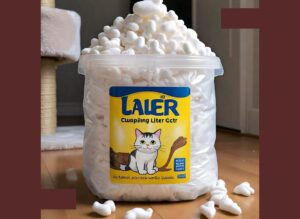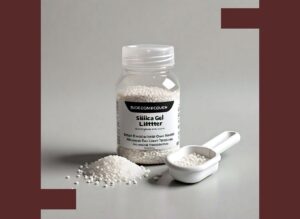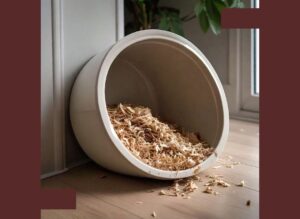When choosing cat litter for kittens, consider safety, ease of cleaning, and comfort for your kitten.
Like human babies, kittens explore their world by using their mouths. The best litter for kittens has large pieces, so they won’t try to eat it. Non-clumping litter is usually better because it won’t stick to their fur or paws. The best litter also don’t have artificial chemicals, scents, or colours.
Tips for Choosing Cat Litter for Kittens:
- Avoid clumping litter until your kitten is 3-4 months old.
- Go for unscented options to avoid overwhelming their sensitive noses.
- Choose dust-free options to prevent respiratory issues.
The best litter ultimately depends on your kitten’s preferences and any specific health concerns.
Best Cat Litter For Kittens
here is some of the best cat litter for kittens;
1. Clumping Litter

The most popular type of litter used by cat owners is clumping litter, but it’s not the best for kittens. Unlike non-clumping clay litter, clumping litter has ingredients like sodium bentonite clay or quartz silica that make liquids form into clumps that are easy to scoop out. These ingredients are safe for cats to touch, but for kittens, the problem is that this litter can expand.
Ingesting Clumping Litter
Just like human babies, kittens explore by putting things in their mouths. They might play in, roll in, or even eat their litter. If they eat clumping litter, it can expand and cause blockages in their intestines.
Since kittens have tiny digestive systems, even a small amount of litter can be dangerous. Kittens are more likely to eat non-food items than adult cats, but they usually outgrow this phase quickly. It’s safer to use non-clumping litter for kittens.
2. Paper-Based Litter

Paper-based cat litter is made from recycled paper, usually shaped like pellets. It’s light, dust-free, and soft on a cat’s paws, which is great for cats with sensitive paws.
This litter is also biodegradable and eco-friendly, making it a better choice for the environment compared to regular clay litter.
- Why it’s good: Made from recycled paper, this type of litter is soft on kittens’ paws and doesn’t create dust, making it great for kittens with respiratory issues.
- Cons: May not be as effective at controlling odors as other litters and can be more expensive.
3. Corn or Wheat-Based Litter

Corn or wheat-based cat litter is made from natural materials like ground corn or wheat. It’s biodegradable, flushable, and better for the environment than regular litter. These types of litter usually clump well and control odours while being safe for cats since they don’t contain chemicals or synthetic additives.
They are a good option for cat owners who care about the environment.
- Why it’s good: Biodegradable and safe for kittens. It’s softer on their paws and has good odour control.
- Cons: It can be a bit pricier and may attract bugs if not stored properly.
Also Check: Californian Rabbit Gestation Period
4. Silica Gel Litter

Silica gel litter is a kind of cat litter made from small crystals. These crystals soak up moisture and help control smells by trapping urine and waste. This makes it easy to take care of. It dries out solid waste, which makes it less smelly and easier to scoop. Silica gel litter doesn’t create dust and lasts longer than regular clay litter, even though it doesn’t form clumps.
Some cats might not like how it feels, and you should watch to ensure they don’t eat it. It’s also better for the environment because it creates less waste than clay litter.
- Why it’s good: Lightweight, dust-free, and provides excellent odour control. It absorbs moisture well, keeping the litter box dry.
- Cons: Some kittens may not like the texture, and if ingested, it may not be as safe as paper or natural litter.
5. Pine or Wood Pellet Litter

Pine or wood pellet litter is a natural, eco-friendly choice for cats. It’s made from compressed wood fibres, usually pine, which break down into sawdust when they absorb moisture. This effectively controls odour while being biodegradable.
Many cat owners like the natural wood scent, which helps mask waste smells and is dust-free, making it ideal for cats with respiratory issues. Though it requires frequent scooping to remove the sawdust, pine pellet litter is less messy than traditional clay litter and is valued for its sustainability.
- Why it’s good: This natural option is safe for kittens and has a pleasant wood smell. It’s biodegradable and low in dust.
- Cons: Some kittens might not like the larger, harder texture of the pellets.
FAQs On Which Cat Litter Is Best for Kittens
Here are some frequently asked questions (FAQs) and answers about the best cat litter for kittens:
What type of litter is best for kittens?
Non-clumping litter is generally recommended for kittens, especially those under 4 months old. Kittens may ingest litter when exploring or grooming and clumping litter can cause digestive issues if swallowed. Natural or plant-based litters, like corn, wheat, or paper, are also a good option because they’re gentle and less harmful if ingested.
Is clumping litter safe for kittens?
Clumping litter is not recommended for kittens under 4 months. Since kittens may play or accidentally eat the litter, clumping types can form hard masses in their digestive tract, leading to blockages. Once the kitten is older and has outgrown the habit of eating litter, clumping varieties can be introduced.
Are scented litters safe for kittens?
Scented litters can sometimes be irritating for kittens, both for their sensitive respiratory systems and their sense of smell. It’s best to use unscented litter to avoid possible allergies or respiratory discomfort in young kittens.
How often should I change the litter for a kitten?
Kittens require a clean litter box to encourage proper litter box use. It’s a good idea to scoop the litter daily and fully change it at least once a week. If using non-clumping litter, changing it more frequently may be necessary to control odours and maintain hygiene.
What about dust-free litter for kittens?
Dust-free or low-dust litter is a good choice for kittens, as dust can irritate their lungs and cause respiratory issues. Opt for litters labelled as “low dust” or “dust-free” to keep the litter box area cleaner and safer for your kitten’s health.
What is the best material for kitten litter?
The best materials for kitten litter are natural ones like paper, corn, or wood pellets. These materials are less harmful if ingested and are softer for small paws. Paper-based litters, in particular, are gentle and highly absorbent, making them ideal for young kittens.
Can kittens use silica gel crystal litter?
Silica gel crystal litter is not recommended for kittens. The sharp crystals may be uncomfortable on a kitten’s paws, and there’s a risk of ingestion, which can cause digestive issues. It’s safer to wait until your kitten is older before considering silica litter.
How can I train my kitten to use the litter box?
Most kittens learn quickly by instinct. Place the kitten in the litter box after eating or waking up, and gently scratch the litter with their paws. Be sure to keep the litter box clean and place it in a quiet, accessible location. Positive reinforcement, such as praise or a treat, can also help in training.
How many litter boxes should I have for my kitten?
A good rule of thumb is to have one litter box per kitten, plus one extra. This ensures they always have access to a clean box. For example, if you have one kitten, having two litter boxes is ideal.
You can also checkout our article on Best Rabbits for Meat Production
What should I avoid when choosing litter for kittens?
Avoid clumping litter, litter with artificial fragrances or chemical additives, and litters that produce a lot of dust. It’s also important to avoid litters with sharp particles, like silica gel crystals, which can be harsh on a kitten’s paws.